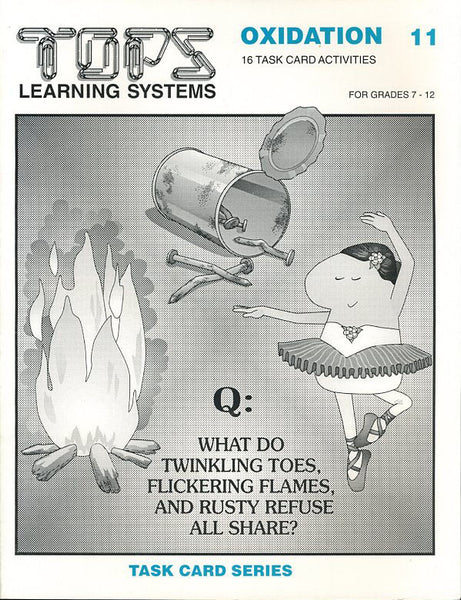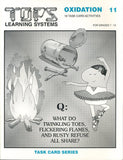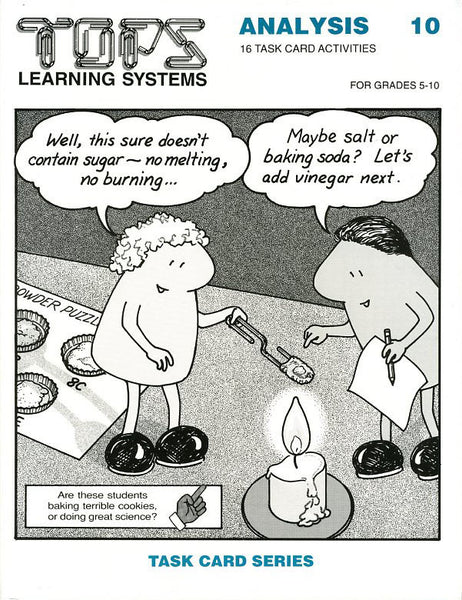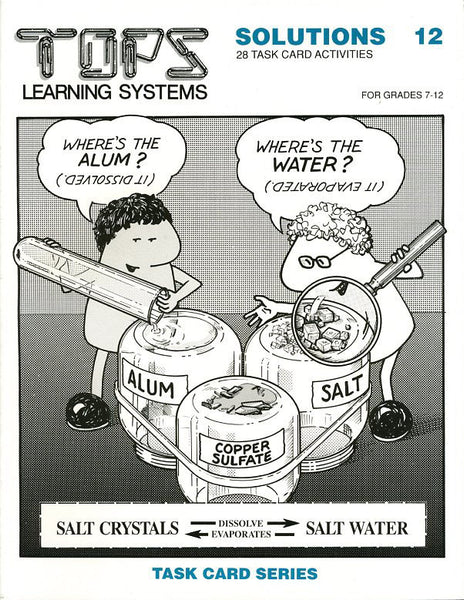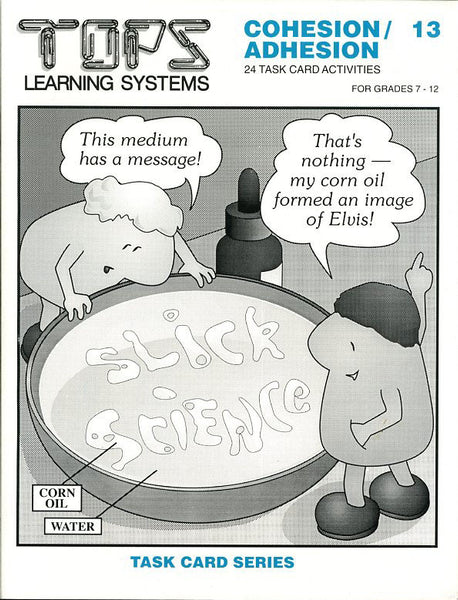#11 Oxidation (grades 6-10)
Regular price $20.95
Soft-bound, 48 page book, 16 reproducible task cards, full teaching notes.
Discover the underlying chemical unity between things that burn, things that breathe, and things that rust. Balance chemical equations, find the percentage of oxygen in air, watch iron burn! Everything runs on common kitchen chemicals.
Oxidation Starter Kit
book not included, please order separately
WE SUPPLY in quantities that serve one student or two students working in a lab pair: index card, aluminum foil, masking tape, test tubes, graduated cylinder, dropper bottles, super-duty D-cell batteries, tubing, clothespins, steel wool, baby food jars, birthday candles, modeling clay, rubber bands, garden lime, craft stick, wire, nail, ceramic magnet, washer
More Information – click any of the tabs below to learn more about this title
Click here for a complete list of materials and convenient shopping.
birthday candles, modeling clay, baby food jars, pint jars with lids, matches, candles, clock with second hand, empty toilet tissue rolls, scissors, produce bags, sandwich bags, rubber bands, plastic or rubber tubing, masking tape, large tubs, wire, metric rulers, wire cutters, size-D batteries, dead or alive, tablespoons, vinegar, baking soda, paper towels, index cards, test tubes, garden lime, plastic wrap, teaspoons, active dry yeast, hydrogen peroxide, craft sticks, graduated cylinders, 100mL unsoaped steel wool, chlorine bleach, clothespins, calculators, test tubes, nails, magnets, aluminum foil, washers with 1/2 inch hole, lids from margarine tubs or equivalent, quart jars, liquid soap, shallow saucers, 70% isopropyl alcohol, eyedroppers, dictionaries- Lesson 1: To discover that candles require a constant supply of oxygen to burn. To understand this process as an energy-producing oxidation reaction.
- Lesson 2: To compare human use of oxygen to that of a burning candle.
- Lesson 3: To collect gas by displacing water. To show that exhaled air contains less oxygen than inhaled air.
- Lesson 4: To study how convection currents sustain a candle burning in the bottom of a jar. To recognize that water vapor is a product of both combustion and respiration.
- Lesson 5: To produce carbon dioxide gas and pour it over a candle flame. To design a fire extinguisher.
- Lesson 6: To learn how to test for the presence of carbon dioxide with limewater. To set up a control as a standard of comparison.
- Lesson 7: To use the limewater test to identify carbon dioxide as a product of both respiration and combustion.
- Lesson 8: To summarize the chemistry of combustion and respiration. To practice balancing simple chemical equations.
- Lesson 9: To produce oxygen by the catalytic decomposition of hydrogen peroxide. To test for the presence of oxygen-rich gas with a glowing splint.
- Lesson 10: To study the slow oxidation of iron into rust. To monitor the consumption of oxygen in this process.
- Lesson 11: To understand that air is a mixture of gases. To estimate the percent, by volume, of oxygen in the air we breathe.
- Lesson 12: To study the rapid oxidation of iron to iron oxide. To identify variables that speed this burning process.
- Lesson 13: To distinguish between hydrated and anhydrous iron oxide. To derive a balanced chemical equation to show how iron oxides combine when heated.
- Lesson 14: To hypothesize why a burning candle creates a partial vacuum in an inverted jar. To appreciate that this, and all hypotheses, are subject to change based on new experimental evidence.
- Lesson 15: To repeat an experiment with uncontrolled variables. To appreciate that its experimental results are not reproducible.
- Lesson 16: To write a balanced equation, based on experimental evidence, for the combustion of alcohol.
We encourage improvisation - it's one of the main goals of our hands-on approach! You and your students might invent a simpler, sturdier or more accurate system; might ask a better question; might design a better extension. Hooray for ingenuity! When this occurs, we'd love to hear about it and share it with other educators.
National Science Education Standards (NRC 1996)
Teachers of science...
A: ...plan an inquiry-based science program. (p. 30)
B: ...guide and facilitate learning. (p. 32)
C: ...engage in ongoing assessment of their teaching and of student learning. (p. 37)
D: ...design and manage learning environments that provide students with the time, space, and resources needed for learning science. (p. 43)
• Represent a central event or phenomenon in the natural world.
• Represent a central scientific idea and organizing principle.
• Have rich explanatory power.
• Guide fruitful investigations.
• Apply to situations and contexts common to everyday experiences.
• Can be linked to meaningful learning experiences.
• Are developmentally appropriate for students at the grade level specified.
Core Concepts/Processes: Burning candles, breathing people, and rusting nails all require oxygen. Candles and people both produce carbon dioxide and water vapor.
Core Inquiries: Inquiry into the common chemistry of apparently divergent systems. • Reexamine an hypothesis. • Explore the relationship between reproducibility and uncontrolled experimental variables.
Core Content:Oxidation reactions • Respiration • Combustion • Rusting • Composition of air • Controlled variables • Reproducible results
Core Content: Compare human respiration with a burning candle and rusting steel wool.
TEACHING Standards
These 16 Task Cards promote excellence in science teaching by these NSES criteria:Teachers of science...
A: ...plan an inquiry-based science program. (p. 30)
B: ...guide and facilitate learning. (p. 32)
C: ...engage in ongoing assessment of their teaching and of student learning. (p. 37)
D: ...design and manage learning environments that provide students with the time, space, and resources needed for learning science. (p. 43)
CONTENT Standards
These 16 Task Cards contain fundamental content as defined by these NSES guidelines (p. 109).• Represent a central event or phenomenon in the natural world.
• Represent a central scientific idea and organizing principle.
• Have rich explanatory power.
• Guide fruitful investigations.
• Apply to situations and contexts common to everyday experiences.
• Can be linked to meaningful learning experiences.
• Are developmentally appropriate for students at the grade level specified.
Unifying Concepts and Processes
NSES Framework: Systems, order, and organization • Evidence, models and explanation • Constancy, change, and measurement • Evolution and equilibrium • Form and functionCore Concepts/Processes: Burning candles, breathing people, and rusting nails all require oxygen. Candles and people both produce carbon dioxide and water vapor.
Science as Inquiry (content standard A)
NSES Framework: Identify questions that can be answered through scientific investigations. • Design and conduct a scientific investigation. • Use appropriate tools and techniques to gather, analyze, and interpret data. • Develop descriptions, explanations, predictions, and models using evidence. • Think critically and logically to connect evidence and explanations. • Recognize and analyze alternative explanations and predictions. • Communicate scientific procedures and explanations. • Use mathematics in all aspects of scientific inquiry.Core Inquiries: Inquiry into the common chemistry of apparently divergent systems. • Reexamine an hypothesis. • Explore the relationship between reproducibility and uncontrolled experimental variables.
Physical Science (content standard B)
NSES Framework:Heat • Properties and changes of properties in matter • Chemical reactions • Interactions of energy and matterCore Content:Oxidation reactions • Respiration • Combustion • Rusting • Composition of air • Controlled variables • Reproducible results
Life Science (content standard C)
NSES Framework: Structure and function in living systems.Core Content: Compare human respiration with a burning candle and rusting steel wool.

